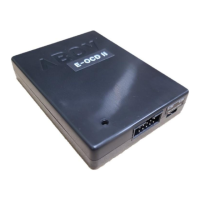1) File property
: If the target device size is no bigger than 64 KB, the compiler only generates a single hex
file. If the target device’s code area is larger than 64 KB, the hex file property must be
selected from among :
Single hex file : Single hex file (linear addressing)
Banked hex file: Multiple hex files (banked addressing)
2) Hex
Hex file name to download.
3) Symbol
: Symbol file name to be used by the debugger software. It depends on the hex file name
selected
4) Do verification after download
: With this option checked, the debugger verifies the code memory after downloading the hex
file.
5) Keep device data (FILE data will be ignored following range.)
: With this option checked, the user can keep the device data, not the hex file data, within the
specified address range. To use this option the user needs to input the address range.
6) CJNE/DJNZ/JB/JNB/JBC SFR.bit command detection (message line)
: This is an important notification. The instructions listed in the message are regarding
comparison or branching that are not supported by some old ABOV devices. Although the
debugger detects these instructions while downloading the hex file, it cannot determine
whether they are instructions or data patterns. In this case, you should check if each
detected part is a real instruction.
7) Save message to file
: Saves the displayed message as a file. This information can be used when the source code
is modified.

